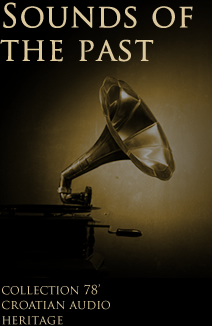The beginnings of sound recording
The history of sound recording and archiving begins in the second half of the 19th century. The entire sound recording history is divided into two main periods: that of acoustic and later of electrical recording. During the acoustic period of sound recording history (1877-1925) recording techniques were entirely mechanical and were limited in terms of dynamic range and frequency response. The period of electrical sound recording began in 1925 and it not only eliminated these shortcomings but also enabled the recording of a larger number of performers.
Here are some of the inventions that dramatically changed the history of music. In 1857 the French typographer and physicist Édouard-Léon Scott de Martinville put together the phonautograph, which consisted of a megaphone or horn placed in a facedown position and a thin membrane stretched over its edges. As this membrane reacted to the vibrations of sound waves, its movements created indentations on the phonautograph’s cylinder. Louder sounds resulted in larger amplitudes, while sounds of higher pitch produced higher frequencies. Twenty years later Charles Cros carried out a study in which he put forward his recommendations on the reproduction of sound, with regard to which he was even assigned a patent number, however he never put his ideas into practice.
The appearance of the phonograph
In that same year Thomas Alva Edison (1847-1931) constructed a device that was able to record and reproduce telegraph messages and telephone conversations. Edison called it a phonograph and the first human words he recorded in this way were ‘Mary had a little lamb’. The first sound recordings made by phonograph were obtained by means of vertical indentations on the phonograph’s cylinder, which in the beginning was wrapped into a sheet of tinfoil and only later coated with wax. During 1878 some 500 phonographs were manufactured and Edison soon developed a ‘perfected phonograph’ that consisted of reusable wax-coated cylinders.
Gramophone and the gramophone record
The next great invention was that of German Emil Berliner (1851-1929), who in 1887 developed a sound recording method in which indentations on the cylinder were made by means of lateral modulation, instead of vertically, as it was the case with Edison’s method. We may consider his invention the forerunner of today’s gramophone record.3 The first experimental disc records were made of glass and coated with soot, while later they were made of zinc and coated with wax. From 1888 Emil Berliner started applying the lateral cut technique on zinc discs which enabled the development of a matrix for the production of records. This method of producing records opened the door to commercialisation and a mass production and sale of phonographs and phonograph cylinders as entertainment devices began the very next year, in 1889. The first disc records did not have paper labels, were single-sided and the information that they carried was inscribed on the disc itself.
Shellac records
Until 1895 disc records were produced from hard rubber and around 1897 they started to be made out of a material called shellac. Shellac is a component of the material that was used in the production of gramophone records in the period between 1896 and 1948. Shellac is a resinous substance produced by the insect Coccus lacca, which is widely present in India, Burma and Thailand. It was dried and ground to be used as one of the components of the material used for producing shellac gramophone records. Shellac records consist of mineral substances, soot and binding agent in the following concentrations – 13.6% of shellac, 37.4% of white and 37.4% of red filler, 1.3% of carbon black (colorant), 0.49% of zinc stearate and 0.92% of Congo gum. The first shellac records were single-sided and measured 5 inches (12.5 cm) in diameter. The 10-inch (25 cm) records appeared in 1901 and in 1903 they were followed by the 12-inch (30 cm) discs.
The interesting thing is that the artists of that time only reluctantly consented to disc recordings, showing resistance and distrust towards gramophone record players and gramophone records as new technological achievements. Nevertheless, Nellie Melba, Enrico Caruso, and some other artists with a worldwide reputation, readily embraced this new technology. Furthermore, in the acoustic period of sound recording, discs with recordings of instrumental music were rare due to technical difficulties occurring during sound recording sessions. In this context the violin proved as the only instrument for which it was possible to get satisfactory sound quality since it could be placed sufficiently close to the recording horn.
Vinyl records
The period of electrical sound recording lasted until the end of the 1940s, when Columbia Records published the first LP (long-playing) gramophone record made of vinyl. Its diameter was 12 inches (30 cm) and it could reproduce a 45-minute performance at a speed of 33 1/3 rpm (instead of 78 rpm, the speed at which records were played back until then) and owing to all this it soon became a standard at world level. The longer playing time resulted from the following:
1. the speed of rotation was cut in half
2. microgrooves were much thinner and made with greater sophistication.
All this, along with significantly better sound quality, was accomplished due to vinyl, a new material for manufacturing records.
A result of further development was a 45 rpm record, the so-called single, and both types became common in the record production industry.
A large-scale production of gramophone records continued until the 1980s and, while in subsequent periods it dropped considerably, it has continued to the present day, with even a rise in the sales of gramophone records that has lately been registered around the world and in Croatia.
